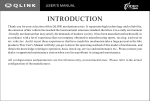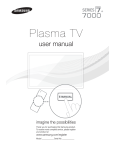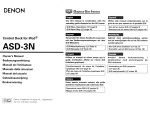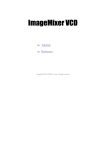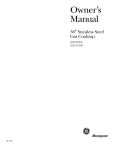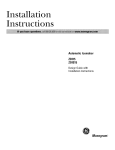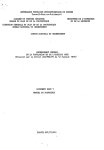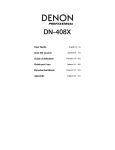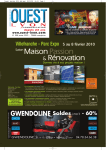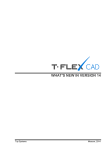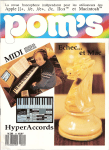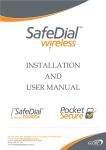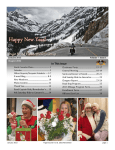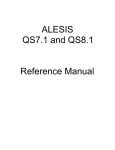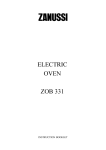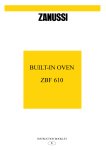Download Volume 4, Number 1 - Goldstar Software
Transcript
Febl1lary 1988
Vol. 4, 1'10. 1
ISSN 0885·40 17
Releasing the power to everyone.
newstand price: $2.00
photocopy charge per page: $0.15
.
-.-.-.-.-.-.-.-.~.-.-.-.-.-.-.-.-.-.-.-.-.-.-.-.-.~.- ._.-
Mainframe genie at your service
-
'-
Those of )OU who have been subscribing to Opell.Apple for awhile probably
remember the cmtoon in our June 1986 issue, in which a fearsome looking IIc
genie is saying to a shaking human at the keyboaro, "Yes, Master?' It's always
been one of my favorites.
'
Christmas morning (I know it's strange to talk about Christmas in the febru·
ary issue, but the January issue was already printed by Christmas morning, so I
couldn't possibly tell you this story in it) the kids woke llathy and me up and we
crept downstairs together. It got kind of steamy about half way down: by the
time we got to the Christmas tree it was obvious that someone besides Santa
had been there. I went to the fireplace and reached for my stocking. As I
touched It, there was a loud humming sound, like a modem pushing 2400
baud. Suddenly smoke was everywhere. Carolers were at our door singing o~t
passwords. A booming voice shook the house with, ' Tom, let's form a strategIc
alliance," I was sore afraid. It was the mainframe genie.
From a pocket deep within his flowing robes he pulled out a clipping from
the November 30th Info World and asked me to read it. I started 10 say that
Steve Gibson's column was the only thing in InfoWorld worth reading, but
thought belter of it. The clipping said thai Apple was planning an on·line com·
munication network for Apple users, The network would be managed by a com·
pany called Quantum Computer Systems, which has a similar product for Com·
modore users. Quantum would operate Apple's service, the clipping said, which
would be sold under Apple's logo. The new network would otTer technical support from Apple itself. Subscribers would use Quantum's own communications
software to access the service.
' Sounds great: I said. 'All the lI.family genies will be able to get together on
line and release l11e power to everyone.'
But as we talked, I could tell that this mainframe genie wasn't happy. The
smoke started to settle and his robes slowly became translucent Through them
I could see a I11reel'iece suit. Then it dawned on me, This wasn't just any main·
frame genie, l11is was GEnie, the online network operated by General Electric.
GEnie had lost its Apple II manager to Quantum and wanted Opell·Apple to
lake his place. 'No: I said, ' I don't have time. '
'
"We'll pay you royalties: l11e GEnie said. "They'renot ,enough: I responded
and negotiations were open. We wreslled. Mainframe gemes are strong, but not
overpowering. I fired up AppleWorl<s and altacked him with memos and spread·
sheets. ' I know how to deal with l11ese suits: I thought to myself.
The GEnie was about to raise its one{ime sign·up fee for new users to
$29.95 from $18. I demanded no sign·up fees at all for paid Opell,Apple subscribers. "I'll do it: the GEnie said, "but no free time and no free manuals' (the
$29.95 indudes a manual and two hours of free time).
I already liked l11e basic rate for connect time on GEnie; $5 per hour for nonprime access (eveninflS after 6, morninflS before 8, weekends and holidays) at
either 300 or 1200 baud; $12.50 per hour for 2400 baud. More importantly,
l11ere are no minimum monthly charges. None of the major national networks
has lower rates; most are higher. GEnie can be accessed with a local telephone
call from almost 500 cities in the U.S. and four in canada. ' What about our
International subscribers?' I asked. 'I'm a multinational company: GEnie
responded, ' expanding around l11e world:
Self·actualization was starting to set in. Uke the other national networks,
GEnie otTers news, shopping, alrtine schedules and fares, financial information,
and electronic mail. And, like the other national networks, the most popular
part of GEnie Is Its bulletin boards and libraries devoted to computers. On
GEnie these areas are called Roundtables. There are two active Apple II
Roundtables on GEnie-a general one and a second one for programmers and
developers.
.
Each Roundtable has its own bulletin board, conference rooms, and bbrary.
The bulletin boards are organized into 'categories;' the categones into ' topics:
Unlike other systems, a user's message isn't deleted afier a few days, but stays
on until the area manager deletes tt. Thus, the bulletin board consists of a large
number of ' threads: each on a specific topic, with tips, questions, and answers
going back, in some cases, two years or more. As negotiations pr~d,. I
started to tllink about editing these threads so l11at the older mformatlon m
Ihemwas all solid, while the newer Information toward l11e bottom of the thread
would contain today's questions and more tentative answers. I COUld.Ima~ine
hundreds of Apple II users working together to release the power, each m hIS or
her own areas of interest. Then I realized I was imagining an issue of OpellApple that had come alive.
.
.
The conference rooms in each Roundtable can be used for onlme meetings.
Agood example of l11e power of conferences is the Binary II file format for making Apple II communications easier (see ' Sending files by carrier bunny: April
1987, page 3.17). Gary Little used the conferencing feature of one of the
national networks to discuss Binary II with other Apple II users interested in
communications protocols. These discussions led to Improvements in his proposed format and to its rapid acceptance in the Apple II community once it was
finalized.
The IibraJies in each Roundtable hold public domain sonware and text arti·
des, as well as many shareware programs that can be examined in the comfort
of one's own home and purchased by sending l11e author the necessary fees.
PIctures and sounds also make up a portion of the Apple II libraries.
As we wrestled, I was never able to persuade the GEnie into paying royalties
at a level high enough that I could hire a professional to manage the day·lo<Iay
operations of the Apple II Roundtables-even If the professional I hired ~ot every
penny. But financial considerations have never been very high on l11e list of pnonties around here, and l11e potential of a GEnie/Open-Apple alliance for
releasing the power of l11e Apple II eventually oveftame me and I signed on the
dotted line.
.
4.2
Open-Apple
Vol. 4, 1'10. I
It will be a few weeks yet before this alliance is settled and organized. I'm
still learning how to use GEnie's s}~tem. I've been to an intrOOuctory confer:
ence in the Apple II area where the GEnie regUlars (many of them already
Open-Apple subscribers) threw eleclronic pies at me. The procedure 'for
Open-Apple subscribers getting free accounts isn't settled yet. bul it will
involve calling a GEnie 800-number wilh your modem and providing your name
and credit card number for billing purposes. Stay luned.
starting with Ihis issue, Open-Apple will cany bits of information aboutlhe
soltware available in GEnie's Apple II libraries, news about upcoming confer'
ences, and lips and tricks gleaned from its bulletin boards.
.
If you're a GEnie user already, you can start sending mail to me (UNCLE-DOS)
and to Dennis (OPEN-APPLE) right now. See you online.
Miscellanea
CIarls changed !rom egg to chick in mid·January. I've given Claris a
mighty hard time the last few months, but we have to live with Claris now, so
I'm declaring a unilaieral cease-fire.
Claris staried shipping a "slightly revised" version of AppleWorks in mid.January. The only revision I can detect from talking to them over the phone is that
they changed the disk label. They're calling it AppleWorks version 2.0. This in
itself is pretty special; you might remember that when Claris was announced,
Apple said Garis wouldn't be allowed to use Apple trademarks.
To its credit. much of Ihe Claris's eatly efforts appear to be going Inlo customer service. II says il intends to provide customer support, which will be
quite a change from how Apple itself handled AppleWorks. The Claris version of
AppleWorks will retail for $249. Upgrades from earlier versions of AppleWorks
are $75. for more informalion on the upgrade, call 800-544-8554 (8;30-5;30 MF Pacific time) and ask for an AppleWorks upgrade packet. They'll mail il to you;
use II to mail your check and original disk (as proof of purchase) back to them.
If you already have AppleWorks 2.0, save your money unlil we find out If
there are any real changes here. If you have an earlier ver.;ion of AppleWorks,
this is your chance to gel the lalest. According to the Claris representative I
talked to on the phone, the upgrade can be made from any prior version of
AppleWorks. Availability of the upgrade expires September 30, 1988.
According to the Wall street Journal (January II, 1988, ra!!e 5) the upgrade
program "is not merely 10 win customer goodwill. When Apple Itself handled the
marketing and support chores for the programs, it didn't bother to keep
relurned warranty cards from soltware customers, much less lists of their
names. Claris's discounted upgrade 'will help us identify those customers: said
Mr. Zeisier (John Zeisier. vice president of marketing), who contends that suc·
cessful soitware companies cuitivate repeat customers. 'We really wish we knew
their names aiready,'"
Maybe Zeisler would like all of us who aren't going to buy the AppieWorks
upgrade to send him our names (along with our wish lists of what we'd like to
see in future AppieWorks versions). If you do write to him, remind him that
about 80 per cent of his revenue is coming from Apple II programs and about
90 per cent of his development dollars are going into Macintosh programs.
Then tell him what you think about thaI. His address is:
Jokll Z.isler
Clads Corp.
UO Clyde Xve.
MoUDtilill View, CA 9400
il you'd rather just cali and ieave a message, the CDlporate phone number is
415-960-1500.
Time stopped for FroDOS 1_1.1 and eariier incarnations 01 ProDOS on january I 01 this year. Clay Ruth warned us Ihis was going 10 happen way back in
October 1985 ("Time short lor ProDOS: page 1.79). Sony I forgot to re-men·
tion it a couple 01 months ago.
ProDOS 1.1.1 and earlier versions were designed to work with a clock card
(the Thunderclock) that didn·t keep track 01 what year it was. To compensate
lor this, the clock rouHnes in ProDOS 1.1. t figure out what year tt is by matchIng the day-ol.[he-week with the date. It's all very complicated, but it works.... for
seven years. Then tt doesn't.
.
Since ProDOS 1.1.1 won't read the dock in the IIgs anyhow, if you have a
IIgs the point is moot. II you have any other Apple without a clock in it-same
resulL II you do have a ciock in any other Apple II, however, you'll notice that
all the files you've changed since the first 01 the year now have a last modification dale of 1982. If you try 10 use AppleWorks, you'll find that it won't even
accept 1982 when you try to get past tbe startup date-prompt. (One ""nders
whether Claris updated the version 01 ProDOS on its new AppleWorlIs disksApple's last AppleWorks 2.0 disks still had ProDOS 1.1.1 on them.)
The best solution is to get ProDOS 1.4 from your dealer or lrom a fnend who
has a 11gs. On the IIgs system disk, ProDOS 1.4 is in a file in the SYSTEM lotder
and is called P8. You need to rename it PRODOS and copy it into the root directory of all the disks you boot with. While you're at it. you might as well get Ihe
latest ProDOS system utilities, too. They're in a lolder called SYS. UTILS on the
IIgs system disk and will work on any 64K Apple that can display 8O-column
text.
ProDOS 1.4 solves the track 0 crash bug we·discussed at length in November
1986 (see "ProDOSbug lound in Australia: page 2.73) and is the version we
now recommend using. We do not recommend either ProDOS !. 2 or froDOS
I.~both have bugs relating to Ihe use of two 5.25 dnves, among other things.
Incidentally, the track 0 bug described in November 1986 was always confined
to 5.25 inch disks. That bug has nothing to do with any 3.5 disk, hard disk, or
RAMdisk problem you may experience.
II you don't have ready access to ProDOS 1.4, another alternative is to paich
ProDOS 1..1.1 as described in Ruth's letter back in 1985. A public domain program by Glen Bredon that installs a similar patch is in file 13047 in Ihe GEnie
Apple II library. These patches only ""rk till 1992, however.
we've finally bad time to start digesting Ibe Beagle Bros 1fmeoat appliaround here_ They're all good. Ultlllmacros is incredible. But QuiCkspell is a work 01 true genius. What makes Quicl<spell so great is its inlerface.
You prepare your document within AppleWorks. You press open-apple escape to
bring up the Timeout menu and scroll to and select Quickspell. It immediately
checks through an internal dictionary of most· used words, .your personal custom dictionary, and an 80,000-word Random House Concise dictionary. Then it
lists on the screen all the words in your document thai it couldn't find in any 01
the dictionaries. You can scroll through this list and select all the words you
wanl to ignore. Then you can scroll through it and select all the words you want
to add to your custom dictionary. You can also choose to replace misspelled
words in the lisi. The cursor point-and-selecl interlace is at its finest in Quickspell.
(The Macintosh interlace supports a similar system, but you have to use the
mouse button to both scroll the list and to sel<:!;l individual items. In the Apple
II interface, the up and down arrows make the cursor scroll and the right and
left arrows seleci or deselect items. You can also select a Single item with
Return. On the Apple II. it is very easy to control the speed at which the list
scrolls and to select individual items. On the MaCintosh, the list scrolls too
rapidly to stop exactly where you want and using the mouse button for two diflerent functions causes lots 01 extra hand movement. Don't expect to read
about Ihis in Apple'S Human Interface Ouidelines, however.)
At any Hme, Quicl<spell also lets you look at your misspelled words in context, in which case you see the whole AppleWorks screen with a small Quickspell menu at the bottom. From the in-context display, you can once again
choose to replace a word, ignore it. or add it to the cuslom dictionary. But from
this screen you can also request a suooested spelling. Quickspell will then dis·
playa list of words spelled similarly to the one you have misspelled. Again, you
can scroll through this list and pick out the spelling you want with a simple
Return.
Quickspell can be set up so that it checks only a Single word or screen
rather than a whole document. It also checks lor double words.
The two big problems I've always had with spelling checkers is lhe amount 01
time they typically take to use and the large number of correctly spelled "misspelled" works they find. Quickspell's three.cictionary speed, the ease with
which you can deal with multipte words at one time, and the ease with which
you can add words to the custom dictionary solve all these problems. 1love this
program. I now lind myself spell-checking nol only Open-Apple, but even the
simplest, shortesl messages. (Timeout Quickspef/, $69.95, Beagle Bros, 6215
ferris Square, San Diego, CA 92121 619452-5500.)
Updates for other programs in Ihe Timeout series all require that you send in
your Original disks as prool of purchase, a $2.50 handling charge, and .. .for
Au/oWorl<s, HacroWorks, or SuperHacroworlls to UltraMacros-$20; for
SideSpread, Superfonts, or Ihe both 01 them to fontWorks-$lO , $20, or $50,
respectively.
Turning foint Software now bas an upgrade for rime Is IIfoIIer that
allows it to work on an Apple IIgs. Back in August ("Cheap accounting: page
3.51) I promised a review of accounting programs, but I haven't gotten very far
on that project. We have tried Manzanita's BusinessWorks, but stopped looking
at it when we discovered it throws away ali your transactions every monlh and
just keeps account totals. This Is how professional accountants do it. I guess,
but a seat-ol-the-pants operation like apen-Apple needs a little more flexibility
than that. I also bought DAC Easy Accounting. but it was so slow once we got it
set up that nobody around here would use it. So we're still using Time Is
Honey OUTrelves. For more on this program, see the last paragraph of my
catio..
february 1988
response to "The Sider and Software" in September 1985. page 70. (Upgrade
$15. program $100. Turning Point Software. 230 Wes.lern Ave. Boston. MA
02134617-782-4877).
One oIlbe least understood selections in the Apple Dg.o control panel
is the very first one-the "display type: for which there are two chOices. color
and monochrome. The user manual's advice. which is essentially to use the
~.' "color" selection if you have a color monitor and the "monochrome" selection If
you have a monochrome monitor, is simplistic.
The manual doesn·t mention it. but this selection does totally different things
depending on whether your monitor is connected to the l5-pin RGB video out·
put or the round "RCA-type" composite output. The composite output is what
other Apple lis use. On the IIgs. this output does exactly what it does on other
lis when the Ilgs "display type" is set to "color:
When "display type" is set to "monochrome: on the other hand. all color signals coming from the IIgs composite output are changed into gray-scale signals.
This slighUy modifies the dot patterns that represent colors on a monochrome
screen from splotchy to regular. in all graphic modes. Internally. what the con·
troI panel actually does is change bit 7 of the IIgs Monochrome/Cotor Register.
which is at $C021 (O=color. l=giay scale). Remember. however. that this register affects only composite monitors.
If you have a composite monitor (either color or monochrome). our advice is
to leave the control panel's "display type" set to "color;" this will give you exact·
Iy the same screen image Ihat you'd get with your monitor if it was hooked to
any other II. The gray-scale option does have the potential to clean up )'Our
screen image slightly. so you may like to try it from time to time. But software
designers who put any thought at all into how color images look on
monochrome monitors 'ill he working from the standard lI·family display; since
most IIgs owners buy RGB monitors. hardly anyone has a system that actually
supports the IIgs gray·scale capability.
With the more popular RGB monitor. the color/monochrome selection does
have an effect. but you have to be in exactly the right place to see it That place
is doub)e·high resolution graphics. App)e created standards for ROB double·
high-resolution graphics for the Apple II family when it released the Apple Color
64K Extended Memory card for the lie. These standards were discussed here In
Open"Appie way hack in May 1985. page 36. and July 1985. page 54. On a lie
or IIc equipped with an RBG monitor. there are three double·high ROB modes.
These are color (140 x 192 in 16 colors). monochrome (560 x 192 in black and
white). and mixed (a combination of the first two). Keep in mind. however. that
these three modes are avatlable on a lie or IIc only when it's equipped with an
RGB monitor; this. too. is rare. Without ROB. lIelllc double-high-res appears as
560 x 192 black·and·white on a monochrome monitor and as 140 x 192 16·
color on a color monitor.
Unfortunately. Apple didn·t follow its own RGB standards on the IIgs. An RGBequipped IIgs supports color and monochrome double·high modes. but not the
l1e/llc mixed mode. In addition. the method for switching between color and
monochrome modes is completely new on the 11gs. On the lie and IIc. RGB dou·
ble-higlJ.res mode·selection involves tickling several softswitches in certain spe·
dnc sequences. as demonstrated here in 1985.
On the IIgs. on the other hand. RGB double·high·res mode selection is deter·
mined by bit 5 of the Video Control Register. at $C029 (O=color. 1,
monochrome; if you change this bit from inside a program. use a read/modiIy/write procedure so that you don·t accidentally change the other bits in the
register)
As mentioned. changing the Monochrome/Color Register at $C021 alTeds
only the composite output. but changing the Video Control Register at $C029
has an effect on both the composite and RGB outputs. This is a little strange
because there never has been and still isn't any such Ihing as a double-high-res
monochrome mode for composite screens (double·high·mono is an RG8-0nly
mode). But if you are looking at a color composite monitor with the
Monochrome/Color Register set to color and stan flipping Ihe Video Control
Regisler between color and monochrome. you will see a color shi~ on your display. it means the best strategy for programmers is to keep the tII'O switches
synchronized. that is. either both set to color or both set 10 gray·sca·
Ie/monochrome. The easiest way to do Ihis is to enter the IIgs control panel and
toggle the "display type:
The Desktop program from early IIgs system disks changes this bit to turn on
monochrome double·high-res. Notice that If you enter and exit the control panel
while using Desktop. the screen display turns 10 multi-colored mush If display
._
type is set 10 color. You can play with this to convince yourself that the
color/monochrome setting really does do something on an RG8-equipped IIgs.
There are many doubters. however. because the setting works only in dou·
ble-hlgh-res. Many new RGB-IIgs users are discovering problems with lI·family
software that uses standard (rather than double) high·resolulion graphics. The
Open·Apple 4.3
problem is that many graphics programs were written by and for 1I/lIenlc users
who had composite monochrome monitors. On color monitors. the nice blacks
and whites that these programs are supposed to display lurn into color smears.
If you use the control panel to switch to monochrome. nothing happens. You
can fix all this. however. by tricking the IIgs into displaying double·high·resolu·
tion monochrome mode and then looking at just half the pielure.
Setting up an Apple II to display double-high·resolution graphics requires that
you hit the so~witches at $C050 (graphics). $C057 (higlrreS). $C05E (double·
res). and $COOO (80 col). To look at just half the pielure. go back to 40
columns (hit $COOC). Now. if you have the IIgs control panel set to
monochrome. you will see a standard resolution graphic on a IIgs RGB monitor
without the color blurs. H's quite simple to modily existing 4().column Applesoft
programs 10 use this "new mode: Simply add a POIIE 49246.0 (double-res on)
to the beginning of the program. Now. as long as the control panel is set to
monochrome and your program stays In 40 columns. you will see a
monochrome single·high·res picture. To return to a standard·res color dispiay.
either change the control panel setting or POKE 49247.0 (double·res oro. This
trick comes from Apple's Apple I/gs TechniGlI Note #29. so we can expect it to
work with future members of the Apple II family, too.
The "filst final" version of Apple ng. /'rog13llIlJJeB Wo_op Cis now
available from the Apple Programmers and Developers Association for $75.
Updates to version 1.0 from bela versions are available for $17.75. The program reqUires the Apple Programmers WoI1lshop version 1.0. 1.25 megabytes
of memory. and two 3.5 drtves or the equivalent.
CI'IS has a new ROM for Its SCSI ..... drives that corrects some problems
when using ProOOS 16 programs such as the rinder. The new ROM is free to
any CMS owner by calling 714-54g.9 I I I. ext 216.
Somebody took a search and replace sword to Ihe January 1988 edition
of the E.A.C. Express. the newslelter of the Erie Apple Crunchers user group in
Erie. Pennsylvania. Every place the word "Apple" should appear there are
instead five undertine chalacters. The editor explains:
"A major concern among user groups during the past year was the implementation of licensing agreements for our computer's operating systems and the
use 01 a certain company's logos and trademarks. The position taken by this
company on the licensing of the operating systems is quite fair for all parties
Involved. However. the permission to use the trademarks aod logos comes with
quite a few strings attached. Basically. we are supposed to put the little 'TM'
mark ~er the first appearance of a product for which this computer company
holds a trademark. We are also supposed to use the little .( in a circle and so
on and so forth... We will try to comply with the trademark and logo restrictions
as much as possible in future issues. it·s too bad thal_ did not put a 'm:
or 'c' in a drcie. or an 'r' in a circle in their printers!"
lllagnets in speakers placed too close to the lIgs analog KGII color
monitor can wash out or warp Ibe colors "" Ibe streeD. Just moving the
speakers farther away from the monitor doesn't help immediately-you also have
to lurn the monitor off for several minutes before it will correct itself. This tip
comes from the January edilion of Ihe Washington Apple(TM) Pi newsletter.
1be Desltop l'ubIi5bing lYewslet16 is a new publication that will feature
techniques for producing effective publications on the Apple II for schools and
businesses. it will be published by Sage Productions. the same company that
publishes the AppleWorks Journal. The premier issue is expected in February
1988. later issues will follow every other month. A one-year. six<ssue subscription is $20 (5677 Oberlin Drive. San DIego. CA 9212 1619455·75131.
Apple has been working bon! to make big sal.. to the federal go....n·
ment" The problem is that most federal contracts require MS-DOS compatibility.
The slots in the Macintosh Sf and Moc II were supposed to solve that problem.
But Apple's "first major victory" in the federal marketplace. according to Charles
Berger. Apple's vice-president of market development. was the sale of 4,000
Apple IIgs systems together with 4.000 of Applied Engineering's PC Transporter
cards. The computers will he used in 270 schools for dependents of U.S. mil~
tary personnel. The company that selected the Apple IIgs for the government
said that it had received proposals from several computer suppliers and that
Apple was chosen because its bid represenled Ihe "lowest life-cyde cost: I
hadn't thought of that hefore. but the Apple II does have a much longer lifecyde than your standard MS-DOS machine. The IBM·PC has come and has been
discontinued. yeI we still have the Apple II.
As we begin volume" of Open·App/e, we're maJdng a few adjustments
to our operation (in addition to the GEnie alliance) that I thought you might like
to know about One problem we've had is that you. our subscribers. insist on
buying stulT from us. Now that. in itself, isn·t so bad. But we've never been set
up to provide you the kind of service you expect from a high-tech computer·
related company. You expect 24-hour order tum-around. Our system here. how·
ever. is modeled after what's typical in the magazine industry-four week turn·
4.4
Open,Apple
Vol. 4, No.1
around if there are no snags. You've complained about it, I've complained
aboul iL and it has come down to eilher getting out of the book and back·issue
business or getting into it with all six feet.
Our current level of sales doesn't juslify all six feet. However, if my own
experience at Irying to buy Apple lI·related books is any indication of what's
going on in the world, the kingdom is badly in need of a mail-order retailer who
carries a large selection of Apple II books. We've decided to expand and
improve our mail order business and to try to fill that niche. We're working on
an order entry, inventory, and shipping system now and expect to be in full
operation by mid·summer. AS part of the change, we're bringing our subscription list back in·house (see May 1986, page 2.25) and we'll resume processing
it with Apple lis. Unfortunately, all this has required that I give up being a cot·
tage industrialist. On December l, Open·Apple began moving out of peoples'
houses and into 2,000 square feet of office/Warehouse space in a top secret
location somewhere east of the Rockies.
An office needs to have people working in it to amount to much. Two of our
work· at· home consultants agreed to become office·based employees; one
wouldn't leave the cottage. still wilh us are Dennis Dams and Sally Dwyer. The
other Sally, Sally Tally, our imaginary Circulation Manager, mayor may not be
moving here from the fulfillment selYice in Syracuse N.Y. that we're about to
stop using; she hasn't decided yel. We have added the locally·renowned Apple IT
and Mazda wizard Tom Vanderpool to our technical·side staff. And our businessside slaff now indudes Steve Kelly. an MBA who comes to us with very rare and
nearly unbeiievable business credentials-he's been a J\ansas farmer for more
than ten ye~ and has a net profit to show for it.
Open·Apple has never had to pay rent before, postage rates go up Ihis spring
for the second time since we started, and each direct mail campaign we do gets
a stightly lower response because our best prospects are already subscribers.
I've had to face the reality that Open·Apple's subSCription price must go up--an
ugly prospect. This will happen March 15, 1988. Our new prices will be $28 for
1 year, $54 for 2 years, and $78 for three years; free airmail worldwide, as
usuai. Renewals at Ihe old prices ($ 24, $44, and $60) will be accepted through
Ask
(or leln
Uncle
DOS
Just when they fmalJy had a good excuse to use an
exclamalion point the gang at IYlbble ran out of themt
Look at the cover of their february issue! 'Interview
with Torn Weishaar, Publisher of OpelI.Apple' ueez.
for more on this controversy, see "Miscellanea· in
June 1985, ~ 1.45, and 'Nibble bytes tongue,' in
A~ust 1985, page /.6:3. In the intelView I'm quoted as
sayi"9 once ~ain that I'd like to see AppleWorlls in
ROM on new Apple /Is. I'm catching a lot of grief about
that one; everyone says it would be too hard to patch
that way and new versions couldn't be used. Sure
would be a big sale for Claris, though.
I thought we 'd carried this correction before. but I
can't find it anywhere. On April 1987's page J.22. in
the program listing in the middle column, in the line
that begins 0010:30A, the number aQer the colon
should be A2, not AD.
/Ig.!
t/i5k ;, I foUow up, Thanlls to several
postal and GEnie correspondents, I've learned a few
addWonai things about the new l/gssystem disk the
last couple of weeks. Please thank them when you
nex.t see them. Meanwhile, pencil in a note on page
:3.90 of last month's iSliue that says to look here for
addiUonai informaUon when you buy that new IIgs.
First, let's set the record straight about the disk·
.,.!em
April I.
fatillg and a«eptIDg the OnandaJ limitations of Open'Apple has been
difficult, but accepting the philosophical "mila"ons of my take·no-prisoners
position on copy protection (August 1987, page 3.50) has been gut wrenching.
The problem with my position Is that It restricts the amount of software avail·
able for Ihe Apple II (and thus the value of the Apple 11) in two ways.
First, obviously, those of us who simply refuse to buy or use any copy·protected software blind ourselves to a major share of what's going on In the king·
dom. Secondly, and far more importantly, Apple II software developers deselYe
to be compensated for their work. The ethic that it's all right to ' make a copy
for my friend/colleague/students' pelYades Ihe kingdom. That ethic is wrong. If
Ihe pelYasive ethic was that asking someone to copy one of their programs for
you was the same as asking them to shoplift a memory card, we would be in a
belter position to demand no copy protection. But that's not the pelYasive
ethic. Have you ever noticed how much bigger and wealthier Apple II hardware
companies are than Apple II software companies? Now you know why.
I am sWI against copy·protection. I will always buy or review an unprotected
program before I'Ubuy or review a protected one. But refusing to look at or use
any copY'protected software In a wOdd where novice users expect to get ail the
software they need for free is pushing logic too hard. (Experienced users, who
have a better appreciation of what it takes to write a good program, appear to
be much more likely to pay for their software.) I want to see an end to copy protection because it's a nuisance to honest users. But the only way to achieve
progress on the copy protection front is to achieve progress on the copies{or·
free front. It takes only a glimpse of holiday reality to reaiize that little progress
is being made there. With no copy protection at all, Christmas could become
nothing more than a Jime for families and friends to get together to cheat soft·
ware developers out
honest livings. Many novice users adually seem to
believe that Jf a program isn't copy protected it must be public domain. We
have to get rid of those ideas. Until we do, honest users will simply have to
learn how to live with the developers who insist on using copy protection.
That's not, after all, impossible.
or
drive light·blinking many of you have been worrying
about while running the Finder. This is normal. The
only way tbe finder can te/l if you've taken a disk out
of a J.5 drive is to repeatedly ask it. But each Hme a
UniDisk is asked for its current status its in-use light
blinlls. Don't worry about it.
Next lee's talk a bit about feons. Icons are those
plc/Ures that show up on your screen when you run the
finder. The idea is that each file type should have its
own'icon. Thus, you can tell a binary file from a text
file from an ApplesoQ file by looking at Its picture. In
addition, icons can be defined [or specific files. for
example, a special icon could be created for an Apple·
soft program called HEARTBEAT. MATH. Just that one
program would be linked to the special icon; other
Applesoft programs would continue to use the generic
Applesoft icon.
All icons that the fiJJder uses come from special
mes that are themselves file /ype $(A and that have a
file name ending in './COIfS' (no, I don't MOW what
the Icon for an Icon file Is). In addition, atl icon files
must appear inside a folder (previously Mown as a
subdirectory) called ICONS.
The I/gs system disk has an ICONS folder in its root
directory. In January, I insisted rather stro"9ly that
this folder contained the same kind of stuR as a bunch
of other folders on the system disk and that those
other folders were inside the SYSTtM folder. Thus,
using blind logic, I insisted ICOIfS should he inside
the SYSTtM folder, too. At the time 1assumed that all
icons the Pinder would ever use would be in the System Disk's ICOIf folder.
However, subscriber David Lyons points out that
every disk you own can have its own ICONS folder.
The Pinder will look for an ICONS folder on all the
dislls it has acceSli to. Since most disks don't have a
SYSTfI'f folder to put the ICONS folder into, it makes
more sense for ICONS to be in the rooI directory.
The file DIALOG. ICONS, which I gave a ' what is this
and why is it here?- notation in the directory listing
on page 3.90, mayor may not deserve the snolty treat·
ment I gave it. lt contains duplicates of some dialogue
icons that are embedded iIJ5ide the Finder program.
The Pinder doesn't use DIALOG.lCONS, but I supposed it's poSliible that other ProDOS 16 programs
could. But even so, why is this file cluttering up the
root directory instead of being in the System Disk
ICONS folder?
The file called BAS1C.LAUNCffER in the root direc·
tory of the IIgs system disk. on the other hand, has
value. Don't drag it to the trash can as I sumested on
page .3.92. Don't believe my nolalion in the aforemerr
tioned directory listing that -it takes longer to load
than to run.' BASIC.LAUNCffER is needed to startup
ApplesoQ programs from wilhin the Pinder.
If you double click on an AppJeso{t program icon,
the Pinder is supposed to run thaI program. To get to
that program, however, the Pinder has to have a way 10
leave l'roDOS 16, startup l'roDOS 8, startup Basic.systern, and, finally, startup the Applesoft program you
have selected. This reqUires a long reach. The Finder
obtains this reach by lelli"9 BAS/C.LAUNCffER what
Applesoft program you wanllo run, and lelling /'QUIT
to start BASIC.LAUNCffER. This is how we get out of
l'roDOS 16 and into l'roDOS 8. BASrc.LAUNCffER, in
tum, loads Basic.system, embeds the name of the
Applesoft program you want to run in the STARTUP
posWon, and runs Basic.system. As you can see, without BAS1C.LAUNCffER, you can't start Applesoft programs from the finder. You can startup Basic.system
from the Pinder by clicl<l"9 on the Bas/c.system /can,
but you can 't tell Basic.system to run anything other
lhan Ihe default program (STARTUP) without
BASIC.LAUNCffER.
Interestingly, the Pinder MOWS to use BASIC
.LAUNCffER with Applesoft programs because
'BASIC.LAUNCffER'is written in tiny print inside the
icon file. The icon for binary files, on the other hand,
doesn't indude this infonnation. That's why you can't
start up a binary file from inside the Pinder. ffowever,
using a b"l®' Apple program called kon Editor, yo u
can add the infonnation about BASICLAUNCffER to
the binary file icon. Neat, eh? Then novice users
could crash their systems whenever they wanled by
clicking on binary files that weren 't actually programs. The same trick would allow you to EXEC text
Open,Apple 4,5
february 1988
files from the ffnder. Apple Imnded out a hetil copy of
its leolJ f4j/or to Apple II developers at Applefest.
but. unlortunately. this tool hasn't surfaced al the
Apple Programmer.; and Developer.; Association yet.
(Actually, icons are even neater than this. You can
make an icon specifically lor all text files that have a
filename ending in ' .EX, , lor example. If all such files
are execable and you tell the icon to use BASIC
.t.AUNCIfER. then you em exec these files lrom the
Finder without endangering novice U5e15. )
While we're talking about the 11000. I'll pass on a
tip from Gfnie user Broce Gordon. Program icons can
be d/ilWed onto the desktop and left there. Run one 01
the programs (with the 'write finder data' option on),
and when you quff back to the 11oder, the icons will
reappeal on your desi<top (il the p~ams can be found
in your drives). You can double<lick on any progrnm's
desktop icon to run it without opening any windows or
lolder.;. This trick should be most useful lor ham disk
users. Don't bother teaching it to your Macintosh
friends; however, because their finder can't do that
unless all the programs come from the same window to
begin with.
A Finder limitation several people have reported
running into is that it won ·t copy the conlents of a 3.5
disk onto {RAII5. As Ofnie's LtNfFUD (Lou flemal)
explains it. ' the flIIOO uses the Iree RAil in the as
Ram card to copy las/er. Bul you are IJying 10 use Ihal
same RA/'f 10 copy ro. When flIIder stalts out. it sees
xxxK {ree, so it knows it can fit the disk you want
copied into j RA1'15. But then Finder loads a/1 it can
inlo the free RAil (same slum so it can copy laster.
When it goes 10 wrile Ihe sluff 10 fIW15. Ihere isn 't
enough 100m, because it has used the space.'
[ found two notes about the system disk in Apple's
App[eLink lechnica[ library. One says that anyone
who upgrades to the [. [ [Igs ROil should Ihen only use
the syslem software on system disks 2.0 or 3.1. lbe
other says that the 11nder 'has a practical limit in 'the
number 01 files per lolder it can handle. lbough hav·
ing 200 or more files in a folder wm not cause a syslem crash. the 110der slows 10 where even the simples! of operaUons becomes unacceptably h'me con·
suming.' Dennis has demonsl1llted this has nothing to
do with the 110der itse[f, however. but happens to aI[
programs using PtoDOS. for example. try this, and
watch how slow things get as we approach the 200th
file:
10 PRill' CBR.$(I) ;'CRWI BIG.DIR"
20 PRill' CIIR$(I) ;"!BUIX BIG.DIR"
)0 !'OR 1.1 10 200
40 : PRm "lilow on file ";I;". ·
SO : Pm"! CIIR$ (I); 'SAVE FILE. ' ; I
60 : nXT
The slow speed results lrom PtoDOS thrashing
around loading the same old directory blocks in and
out 01 buffer.;. The moral: use more fo[der.; (subdirectories) so thai you don'l have more than about 50 files
in any single folder.
Subscriber Steve Busey poinis out that you can set
up a tw()-volurne hard drive so that the first volume
(JHARD [, for example) boots into PtoDOS 8, while the
second volume (/ HAKD2, {or example} contains the
ProDOS 16 system files. To staJtup PrvDOS 16. you simply set the prefix to {HARD2 and execute PRODOS.
You can easily do this from a program selector such as
l'toSlL, IIyou want.
Subscn"ber Wjlber !'1ardis poin~ out that once
you've created a syslem disk. you can copy many PtoDOS 16 applicaOOn programs onto 5.25 floppies. Once
you get aI/ the tools. lonis. and print driver.; onto the
system disk. older floppies often have enough room
lor Ihe actual programs. '[ have. lor instance. copied
!lJU1i5aibe IJS 10 one side of a 5.25 disk and Top,
Draw to the other. '
Getting down to business
I've read comments in your publication about using
Apple lis in 'commercial producti~ty" applicalions. Let
me tell you about how we: do it.
We utilize eleven enhanced Apple lie machines-all
using AppleWorks-to operate an electronic instrumentation business. We acquired our firsl machines in late
1984 and have taken advantage of improvements in
AppleWorks itself (version 2.0). and in various hard·
ware (I-RAM Ultra III, UniDisk 3.5) and software add·
ons (PinPoint. Point·to·Point, and TimeOut. for exam·
pie). w.·re experimenting with some relatively new
AppieWorks file·compatible accounling software, too. If
a IIc fails, we have a couple of extras. so we just whup
it out an' drag the broken one down to the local Apple
boys for service,
Every single business day, we use word processing,
spreadsheets. and data base operations, and accessory programs for communications and spell-checking,
exchanging disks and files. filling in stilndard order
and invoice forms, making mailing labels, using informalion from our IIcs. We have a portable IIc (a /a Roger
Coats, in San Diego) utilizing a Prairie Power battery
pad<. an LCD display. a Diconix battery'power«l print·
er and a ProCom modem, which we regularly carry to
our "Aberdeen, Scotland office to communicate with
the home office network. W. plan to put a laser printer
on line this month, Several employees have personal
lies at home. which they readily use to do the 'home
work· regularly done by successful businessmen t.oday
(although several of our guys admit that they have to
share the home machine with their families). My
daughter at college regulariy exchanges files with the
business network and with our home machine using
her enhanced lie.
We've solved lots of minor software and hardware
problems to make our system work and grow, but
Apple support people-local and regional-were, and
are, no help at all. It's a real pity that other businesses
who would like to do what we do (and save the money
that we've saved) are shunted off to Madntosh-Iand by
the locals. who steadfastly deny that a IIc can be productive. And, worse than that. many of these fine
potential II users become convinced by others that
only MS-DOS'II do it. and we don'l hear much from
them anymore (yes, we do have one MS-DOS unit in
the corner, and, yes, it'll soon be connected to the network as well). We know the limitations of the IIc CPU
and graphics, but let's face it-those limitations mean
very little in actual, real daily business transactions,
Now. don't get me wrong. The local Apple folks
didn·t actually light with us as we bought or inquired
about, the various comj>onents we needed. They just
said 'We don't know about lhat.' nearly every time we
asked a que.stion. It was too much to expect the Apple
locals to know about enhancing AppleWorks. or
enhancing IIcs, or doing a bit of networking. I guess.
After a bit, we. like other slightly knowl«lgeable
Apple . business users, bought our goodies by mail
order (we succumbed to the ·Why pay more from
someone who won't help you?· syndrome), causing
the locals to decide that there wasn'l enough Apple II
business around to warrant their attention, as they
leaned [urther toward MWOS contraptiOns. II's a dog·
gone shame that we businessmen must also be computer experts, and work against the local Apple sales
effort to get the job done. white the MS·DOS boys
down the street will gladly sell you the whole lot.
Our business network operates just fine. We don't
b~ about it-we just use It. II's nothing [ancy, but I I
machines with compalible, Inlegrated sollware Ihal is
easy for new employees to learn and a varied collection of accessible printers-Apple and otherwise-is
nothing to sneeze at. my friend. Macinlo5h. M5-DOS. or
otheIWise.
To top thin!!' off. we developed and built a cheap
standby recharyeable power pack that operates each
IIc for 2 hours during power glitches and oulages. It
lets us really ulilize IIc RAMcards and RAMdisks. It
costs 30 bucks to make. and any Apple lie user can
get all the parts al Radio Shack. Some folks sell them
for as much as $ I69. This Iitlle gadget, if sold or mar·
ket«l by Apple. would allow more folks like us to use
lies as solid productivity computers. If anyone would
like a Radio Shack parts list and schematic for our IIc
slandby power unil, just drop a SASE to us, and we'lI
fix 'em up.
How many more bu~nesses operate Apple II office
systems like we do? Why has Apple deliberatety cho·
sen Lo ignore us, and our needs? Why can't we get info
on how to link lies together, or to laser printers, from
the local Apple boys? We've been templed to find, Or
start. an Apple II ' business only" users group. Maybe
there is such an organization, and we're further behind
than I thought. Oh. well. back to exchanging files and
graphics with Scotiand, as we prepare our 400K one
year operatfng plan spreadsheel. and print it out on
the laser printer as the Customer service guys run a
database failure sort for a customer who has asked
Marketing for a big re.quote. while Engineering fiddles
with .. ,
George Smith, President
Electro-flow Controls, Inc.
P.O. Box 870
lIissouri City, TX 77459
Useful computing, ordinary people
I have o~en pondered why the Apple II has such
appeal to me after using a It-Plus then a Ite. It has
been very difficull to actual~ pin down the reasons for
my loyatty. Certainly much has to do with accumulated
knowledge but there is much more to it than that.
Probably the major factor. and one which goes against
conventional wisdom in the computer world, it that
Nsimpler can be better.· This leaves me feeling in control of my computers (one at home and one at work)
and not feeling ovelWhelmed and useless when something unpr«liclable happens.
J regard myself as a serious user. I work in the area
of youth policy and often write reasonably lengthy doc·
uments, a regular newsletter, and a welter of short documents ·as well as maint.1ining a number of smallish
dalabases. I use my computer every day at work and it
really is a personal productivity lool rather than an
embellishment on my des~
It sbikes me that. many people writing about computers are people who write about nothing but computers. As such they are all too infatuated with ·new·
and ·powerful- and "'fast.. and ·complex· and so on.
This is wonderful if you have nothing to do all day but
play .with the latest 386 monster and explore the intricacies of OS(2 but what about us folks who use a
computer as a means to an end rather than as the
end? Similarly. I find many people using MS-DOS com·
puter.; equally hung up on these marketing concepts
and not actually doing much at all with that power and
complex software. The price they pay is a most
unfriendty operating system. a plethora of slandards
(which OOS versions? ...which graphics standard?
.... what format word processor files?), and noisy fans.
If there is one thing than an Apple (and AppieWorks)
can do well. it is make useful (rather than esoteric)
computing available to ominary people.
I'd also like to endorse the comments of every second writer to Open,Appie and lamenl Ihe lack o[
knowledge of dealers. They are no better here than
anywhere else. I recently had to tell one about the lie
to II!!, mothelboard upgrade option among a number
of other things.
4.6
Vol. 4, 1'10. I
()j)eD"AJ)J)le
A possible solution to tile chronically inadequate
support provided by many deale" would be for them
to enlist local Apple II afidonados as "experienced
customer advisors- to speak to potential or actual pur·
chasers about the possibilities of their computers.
Something as simple as giving a potential customer
the name or an experienced local user as a support
person would be of enormous value to the dealer; the
local support pe"on could receive special discoun~
as payment. EveI)' happy user is worth a great deal to
Apple. Conversely, every unhappy user who puts their
system away in frustration is a minl.<Jisaster. I, for one,
would be quite happy to be involved in such a
scheme.
Ian Wright
Ballarat. Australia
Stone Solid Apple
I've been reading your comments and letters about
tile future of the Apple II with interest. Where will new
Apple II productivity software come from? From fools
like me who still believe in the Apple II!
fools who believe that if you can write a decent
datlbase manager for a 48K computer. you should be
able to write a great database: manager when you have
128K to work witll.
Who believe IIlaI people are interested in fast. pow·
erful programs thai don·t use graphics and sound.
even if Apple Computer generally isn't.
Who love the Macintosh and the Apple II. but suspect that trying to turn an Apple II into a color Macin·
tosh simply cos~ too much in both speed and memOf)'
to make sense for a lot of applications.
Who are willing 10 buck all of tile trends and go it
alone. without big-bucks finandng (the way we did it in
the ·old days·, when personal computer software was
a vibrant innovative cottage industry) producing highpowered applications software for a computer that
·conventional wisdom- says won't pay off_
Who unde"tlnds tIlat fi"t time computer use"
soon become experienced computer users, with needs
tIlat o~en can't be met by software designed for first
time users_(But they're still computer users, not computer programme", And a good program designer
should be able to give those people tile power they
need witllout (orcing them 10 become programme".)
fools who are willing not on ly to produce software
for the Apple II. but to make a commitment to it.
Stone Edge Technologies is committed to making
DB Master Version Five and Version Five Prolession·
al the high·power data base manage" for the Apple II.
Wilh mulU.file relational capabilities. multi· user ver·
sions, and one of the most powerful report generators
available for any peo;onal computer. we're giving the
Apple II market a chance to prove that the pundi~ are
wrong-that there is a market for high·powered soft·
ware for the Apple II.
Barney Stone
Stone Edge Technologies. Inc.
p. 0. Box 200
Maple Glen. PA 19002
Blessed are the disk rescuers
You mentioned Pete Johnson as a source of disk
repair in an ea~ier issue (November 1986. page 2.76).
I have had, unfortunately, several occasions to need
his services. He has always done well for me. The last
time. I needed help FAST. I express-mailed tile disk to
him; I had it back the third day. I heartily recommend
him.
Brian eastman
Cincinnati, Ohio
Johnson's address is P.O. Bru 5. New wndon. MN
56275.
Solving for double-blanks
A simple way to get around the Wcalculated double-
blank @NA" problem mentioned in ' Multiplan upriate·
in December 1987. page 3.85. is to create a duplicate
of what you want to print on the right side or tile bot·
tom of your work area. To create this duplicate, where,
for example. cell AI 0 I corresponds to the original AI.
use the formula@IFlAI=O. @NA.AI ). Using the copyjre>
atlve command it takes just a few keystrokes to create
this duplicate spreadsheet provided you have enough
space_
t found in practice that I want the cosmetics of
blanks substituting for zeros only in that part of the
spreadsheet that I print into a report. And that is usual·
Iy only the summaI)'. The bimer the part with the cosmetics. the slower will be the speed of calculation_
That's why I try to keep the cosmetic part as small as
possible.
Another possibility. when there are just a few
columns or rows that contaIn calculated double
blanks. is to use the @IF function to determine where
the blanks are. For example to add AIO and All when
eIther could contain a double blank, use
@IFIAIO· O.AI I.@IF(AII=O.AIO.AIO+AII).
Werner Kubelka
Niterol. RJ •.Branl
Use a -nag cell- to blank zero entries in worksheets
(December 1987. page 3.85; June 1987. page 3.39).
Set the flag to 99 to see the spreadsheet as it would
normally appear and to calculate tottl~ Set the flag to
zero and recalculate to blank out Ute zero cells for
prin~ng.
In the dati cells. use @IF witll a formula such as
@IF(@AND(flag=O.result=O)[email protected] lt). where 'flag'
points to the cell you will use as a flag and "result" is
the formula tIlat gjves tile dati you want displayed in
th~ cell.
In cells that make calculations using these data
cells. use a formula such as @IFlflag-O.self.calculation). where ·seW causes the cell to return Its own
value and ' calculation' returns the data you wanl displayed in this cell. Fo",e calculation of the worksheet
with the flag set to 99 to obtlin tile correct results.
then set the flag to 0 and recalculate to replace the
zero cells with blanks.
For installing custom printers, a word processor file
of printer code macros would be an efficient distribution medium. The macro could start at the point where
you give the printer a name.
Has anyone noticed that Randy Brandt is licensing a
runtime ve..ron of UltraMacros to support task files?
You published a letter oi mine In September
("Thinking about datlbases: page 3.63) In which I
said the AppleWorks word processor flnd and Replace
commands take about 10 per cent longer with versIon
2.0 than with ve"ion 1.3. My AppleWorks 2.0 word
processor was slower because it had escaped my permutation heap unlabeled with AutoW",ks on it. In real·
ity. the 2.0 word processor ~ slightly faster.
I second the motion for a discussion of what a 16bit (or any) AppleWorks could and should do. For
example. version 2.0 still cannot handle a DlF file witll
optional headers, a bug you exposed In detail in
August 1986 (' AppleWorks Difficulties: page 2.56).
Robert Ericson
North I'rovidence. RI
Along with his letter. EriCS<Jn sent us a copy of a
new. second edition 01 his book AppleWooo TIps
and Tetlln/ques (Sybex). I liked the first edition 01
this book so much (JanUill)' 1986. page 1.97) that part
01 what I said ended up on the back cover 01 the sec·
and edition_ The new edition was just generally
spilled up with new Iricks. expanded to include all
the new sluff in AppfeWorks 2.0. and has a whole new
chapter on macro programs. Here's a Iypical Ericson
insighl from the macro chapter. "The &agie fJro5 manual draws no line between macros and control prcr
This makes macros appear to be mae compl>
cated than they really are. "
If you buy just one book about AppkWorl<5. Ihis is
the one to get.
gmm~
AppleWorks, 8 & 16
Your ongoing discussion of what the next versIon of
AppleWorks sllould do Is intriguing. However. the iocus
oi tile discussion has been on the IIgs and what a 16bit AppleWOrks should be like. Why not bring any
enhanced ve";on of AppleWorks 10 the 8·billle and IIc
too?
Both B-bit and l6-bit ve"ions o( AppieWorks sllould
be included in the same box. The 16-bit version
sllould use the 16·bil code for improved performance.
not new features, as you have suggested. To the user,
and to AppleWorks add-ons like Timeout. both ver·
sions should seem identical. To allow add-ons to be
compatible with both ve"ions. the developer hooks
should be wri tten in 8-bit code.
Now. how should the program i~elf be improved?
For one thing. the three AppleWorks applications
should be enhanced to bring them up to sttnd-alone
quality. In the word processor, for example. how about
right justification, a way to print either formatted or
unformatted text files witlJout using a custom printer,
and wildcarn and carriage return options for find and
Replace?
A way to embed special printer codes in word pro·
cessor documents is needed_ Why not allow ten custom character strings per printer? In the worn processor. select U(ser)O through U9 to select these strings.
which would appear a5 carets in the text. These commands would be sent to the printer (but not.counted in
tile line length) during the printing process.
The data base needs more flexible reporting capabilities and the spreadsheet needs more functions and
string-handling ability. As Lowney SlJ!!lested. a path·
name selection menu should be included and should
be invokable any time a disk ~ accessed. AppleWorks
should display subdirectories when loading a file and
allow tile user to open tIlem and look inside. Text and
DlF mes should be loaded from a menu. Mouse support. in the AppieWorks spirit. that does not replace
tile sttndard AppleWorks interface. would make Apple·
Works ,s;mpJer for new users.
AppleWorks should recognize and use any combination of aux·~ot. standard slot. and IIgs memol)'. but
should be smart enough to leave RAIIdisks alone. We
need more word processor lines, data base records,
spreadsheet cells. and a larger dipboard. The desktop
should be able to hold a larger number of files.
flnally. AppleWOrks needs something similar to Bea·
gle Bros' Timeout manager built in, to support applications that run within AppleWOrks. Add-on programs
should be able to access evel)' neceS5aI)' AppleWOrks
I/O, disk. and memol)' fealure. New applications
should be able to appear on the Add Files to Desktop
Menu and sllould be activated when you load a partic·
ular file type. And. of course. AppleWOrks develope(s
information should be made available in the form of a
technical reference manual.
Jerry E. llindatl
Grove City. Ohio
75·file bug
I have all of my AppleWorks mes carefully arranged
In SUbdirectories on a Sider 10 meg drive. Some of
them are getting rather full. One of them.
j AW/DATA/LETIERS/COMPUTEIt currently has around
75 files. When I attempt to load any of them into
AppieWOrks 2.0 on my IIgs. everything proceeds fine
until the last file specified is loaded. AppleWorks then
tel~ me it is getting errors toying to read .. (empty dou·
ble quotes). At the bottom o( tile screen is the 'Press
"--.
Open-Apple 4.7
February 1988
spacebar to proceed' message.
Here's where it gets weird. If I press Ihe space bar,
the program crashes hard. SO hard that a Timeout can·
trol-reset will not recover the program. But,o •. if 1 press
Escape instead of the space bar. I go back 10 the main
menu and aI/ of the files I have specified have been
properly loaded. This happens even if I specify only
one file.
I have done some tests to try to figure out the
sourte of the trouble. I've tried several copies of
AppleWorlls 2.0 under several versions of ProIlOS.
Always the same. However, under AppleWorlls 1.3 I
never have a problem.
Rex Creekmur
Grandville, Mich.
We can 't explain it either. We've had repotts that
problems like this happen wilh il!i few il!i 64 files in a
subdirectory (July 1987, page 3.45) and reports that
AppteWorlIs 2.0 is designed to handle a nmimum of 85
files in a subdirectory (Auyust 1987, page J.56). We
once a C1lJlied a patch to expand this (also page J.56),
but it doesn't work, as I ruefully admitted on page
3,69. I suspect the only short-tenn answer is to put
fewer files in each subdirectory. Since Claris has bjg
plans for customer suppotl, perhaps we can look for a
fix to this problem from them.
Database fixer
I've also experienced the AppleWorks 2.0 database
file bug reported by Eugene Whitehouse and Sidney
Powers (December, page ,,67; January, page 3.96). I
don't know what's causing it, but I've gotten quite
good at recovering the files. If Copy 11 I'/us is used 10
copy a damaged me to an otherwise emply disk, the
database file header will be found at track 0, sector I.
Byte :l6 ($26) in this sector gives the number of report
formats in the file. I've had success at both trial and
error changes to the value and at studying the first 50
lines or 50 of a word processor ·text- file: load of the
database me to determine just how many report for·
mals are left.
Robert 1. Hildebrandt
Pleasant Ridge, Mich.
Those who would rather use ProS/lL'. Block,Wardell to make the change need to teU it to f(ol1ow) the
correct file, then change byte $26 in the file's first
block.
Another copy machine
Another way to make more than nine copies of a
....ord processor document without having to patch any·
thing (' AppleWorks as copy machine: Delober t 967,
page U t) is to create a database file with just one
category. rut a single word from your document in this
category, then copy the record until you have as many
records in the database as you want copies of your
word processing document Use mail merge to insert
that word hack into the document from the databil!ie.
AppleWOrlls 2.0 will print the exact number of copies
that you waol
Lany Jones
EI Paso, Texas
ADB.READER bug found
There's a bug in your ADB.READER program in the
Harch and June 1967 issues. AppleWorks database
records begin with a two-byte length. When a record
starts In the very last byte of the buffer. however,
ADB.RfADER gels only the first byte of the two-byte
length. The second byte is whatever garbage happens
10 be one byte past the end of the buffer. To.fix Ibis,
the end 01 buffer pointer (BEN) should be aimed at the
last byte of the buffer rather than one byte beyond Ihe
end of the buffer. Change line 1052 on pages 3.1 I and
to;
In March's line 1052 you divided Ibe 16384 by 2; in
June you said this wasn't necessal)', so I didn't do it
here.
Jim Luther
IIansas City, Mo.
60,000,000,000,000,000,000 possible combinMions.
DeskUHJls also includes a calendar, ca/culalor,
nOlepad, dialer, envelope addresser, clock, Clipboard
converter (for moving data directly between database
format and spreadsheet format, or vice veoo, without
using Dlf files), upper/lower case convener, word
processor page preview, word counter, and, of COUf.5e,
a puzzle. 1Imeoul DeskTool5 is $49.95 from Beagle
Bros, 6215 ferris Square, San Diego, CA 92121 619452-5500.
Asneakyright-juslify
aedi revelc A
Here's how 10 get page numbers (or any other text)
right justifred inside an AppleWorks header. Use open·
apple·O(ptions) HE to start a page header, and JU to
force full justification. Enter Ihe text to be right justi·
fied, a blank space, and then about 10 sticky·spaces
(open·apple-space bar). ·1( you. want the rest of your
text to be unjustified, return to open·apple·(O)ptions
and enter W. Now, put the insert cursor at the beginning of your header text and press the space bar until
the sticky spaces drop 10 the second tine of the head·
er. Your AppleWorks screen should now look some·
thing like th~:
.
I was recentiy approached by an associate who
operates a small business. He has a number of data
disks that are vulnerable to unauthorized copying or
use. He wanted me to ~ist him in the selection of an
encI)'ption system.
Mter considering his request, I derided to simply
reverse the direction of the drive motor in his second
drive, which is where he always puts his data disks.
Onte the direction change was made, we used Copy
II-Plus to copy his disks from the normal drive to the
reversed drive. The system and sofiware don't know
that a change was made. But the disks made on the
reversed drive can't be read by a nOfmai drive. The
major benefit of this encryption system is that the user
h:as no added steps, pre-boots, or operator intervention, so there's no due that something is different. t
put a switch inside the drive. operable through a hole
in the bottom, so Ibat normal operation of the drive
can be achieved without disassembly.
To make this modification, take a drive apart and
lOCate the drive molor. There are normally four wires
connected to the motor, two for DC power and two for
speed control. Disconnect one of the pairs and see U
the drive motor will come on. If it does, you 've disconnected the speed control wires and you should reconnect them.
. Once you've fIQured out which pair of wires provide
the OC power, look at the back of a DPDT switch and
you'll see six ptaces where wires can be connected,
three on the right side and three on the left side. Solder the power lines from Ibe ciftuit board to the two
top connectors, one to the right and one to the left.
Also attach a wire from the top right connector to the
bottom left connedor and from the top left connector
to the bottom right connector. Finally, solder new wires
going to Ibe drive motor to the two middle connectors,
one on the right side and one on the left side. With the
switch in one position, the drive runs normally, in the
second position it is reversed. Move the switch only
when the drive motor Is off.
.
ten Powelt
f1nksbury, Hd
,.,5
1052 BER ; BIIG + 161B4 - I ; R!I! al!J;end 01 bull".
........P'4' lItade,
--------Justified
page •
AAAAAAAAA~
-- ------'O'n justified
The caret alter the word 'page' is the page number
caret, the other carels are sticky-spaces. AppleWorks
allows only one line of text in a header. The idea here
is to push the sticky spaces into the second line,
where they won't be printed. But they will drag the
page number 10 the right margin because the header is
being printed wilb fuil justification. This right justifies
the page number even if it grows to a two- or threedigit number.
If you are using one of Ibe proportionallypeslyles,
you may have to use more spaces in rront of the text
(untillbe text is about halfway across the second line)
and more sticky spaces to get the trick to woO<. This is
beaulSe the space is a vel)' narrow character with proportional typesIyle&
You can also use this trick outside of headers-ror
example, in a table of contents-but in this case the
sticky spaces will actually be printed il!i a blank line.
SO you have to plan your printout so that it appears
the output ~ (at the least) double spaced, because
every line fonowing a right-justified line must be blank.
NansJuergen Kuehne
Garbsen, West Germany
AppleWorks passwords
I was wondering about the possibilily of patChing
AppleWorks 2.0 to add a password routine to prevent
casual accessing or sensitive files. This valuable fea·
ture is available on 5ymphonyand tt would be a good
addition to AppleWorks.
John H.lllein
Spring. TeJIil!i
The best soluUon we can think of is Beagle Bros
'timeout De:YTooIs, which contains a routine called
file fncrypler that can be used fo encrypt files from
within AppleWorks. You load any type of AppleWorks
file you want to keep secret onto your desktop,
encrypt it using a password ofyour choice from one to
ten characters long. and then save it. Encrypted files
look like gibberish. To decrypt, load the file onto the
desktop, reenter your pilliSword, and the file will be
restored. If the file is sfill gibberish, you entered the
wrong password. At this point you can fly to guess the
right password, but it may take some lime to enter all
ProDOS time
I want to access the Apple Jigs clock from Applesoft
under ProDOS. I tried PEElling at locations 49042
($BF92, minutes) and 49043 ($BF9" hours), but
these locations are only updated during disk access.
Do I need a machine language routine to calt the IIgs
toolbox, such as the one you published back in April
(page 3.21), or is Ibere an easier way?
Glenn Calderone
fountain l'alley, caJ~.
lbe easy way is to use the ProDOS Hachine Lan·
guage Interface OIT_ TIHE call. This call updates the
locations you mention with the current time. Using
this call, rather than a Ilgs tootbox call, makes your
program compatible with any Apple 11.
Here's a short program that Dennis wrote to show
bow to do this:
10 POKE 768,11 : R!I! 0300:10 00 BI' JSR $"'00
20 POll 169,0 : REI( 0303 ;82
.DA 1$82
10 POKE 770,191 : REI( 0304 :00 00
.01 $0000
40 POD 711,IlO : REI( 0305:1B
CLC
4,8
\0
60
10
SO
10
100
Open,A.pple
POI! 712 , 0
POI! 11l,0
:
:
.on 111,24 :
P<lIm '1~ , 96 . :
CALL 168
PRm ",joe II
REI! 0306:60
R'S
mI
REI! $82 II GET . 00:
PJX
GO
pmatter
tail ,
lilt
'; Pw:(lI043);": ';_111012)
files cannot be legally distributed as your article
implied.
Greg Branche
Zedcor
Tucson, AZ
insert disi with PROOOS 1.1,1
PROOOS,A$2000,TSYS . (load ProtlOS 1.1.1)
On rereading my response I nnd I did imply that the
whole package could be redi5tributed, but f didn 't
mean 10. I'fy goal was to compare the cosl o( aclually
di,lribubng programs wriuen with each o( the vanous
Basics.
BLQII)
Printing pastels
I found
through t A o( /'roDOS, it live5 at $5900 i( you blood
Pl!ODOS at $2000_ In version5 previous to /.2 ft lives
at $5700. So, (or example, to nx"e the program from a
vel>ion /. t.I Pl!ODOS file to a version I A Pl!0D0S
me, do this,
th~
hint quite by accident, but now I u'" it
any time I want to print pastels, rather than vibranl c0lors, with my tmageWriter tt Simply ",t the printers
paper th ickness control for one additional sheet of
papa Th ~ makes the printer print lighter than It normalty does, something you might want to u", with a
baby announcement or shower Invitation. The one
problem is that black won't be as black as it should
be,
Does everyone know you can return to the find er
from the Apptesoft prompt on the IIgs by just typing
' BYE'?
Lowell Lutz
Phoenix, Ariz.
inMrt • backup "py of • disk "'Idlnq PRODeS l.I
BSAVE BIRDS,BYE,A$5100,L$300 I.... quit codol
BLQII) 'ROOOS ,A$2000,TSYS
Iload 'toOOO 1.41
BLOOD BIRDS.BYE,A$5900
(overlay Bye)
BSAVI PI<OOOS ,A$2000 ,TSYS
(tt,SAW Pt\lIlOS 1.1)
Bird's program isn't sold separately, ·It', Part 01 the
ProDOS'ltnage on most SoJIware Touch and Beagle Bros
products.
the output 01 a program or a CATALOG, but I can't
OPEN .PRlmER as a file in immediate mode. In
deferred mode, the error 'RESERVED WORD' comes
up wben LIST is used in a program,
R. C. Allison
PUnta Gonla, Fla.
I havej ust received a copy or ProDOS 8, vmion ']:4
on a commerdal program disk. I would like to know of
a standanJ way to install Alan Blrd's Blrd's Bel/er Bye
quit routine into the various versions of ProDOS 8.
N. W. Madison
Bellingham, Wash.
fent version, lay it into the new version, then BSAVr;
the new version with Bird's program eml>edded in it
Here are the details you need to know to do this.
The program has a length of $JOO.' In versions L2
Is.rt:\etl, ediBl, ~ am
© Copyright 1988 by
Tom Weishaar
with help 1l0III
Tom VanderpOol
Dennis Dams
Sally Dwyer
Steve Kelty
Most ~ ~ M tm;prrS p.Cished it ~ are jll.tIIk:
d:m&il " tM1 be c:q:8:l arw:I disrilded wtto1 chatge. AWIe user ~
an:! sig'i!icanlchtsl'l'9f ot:Wl ~tI re;m a1i::e!'trcm tine Ie ire
~specilicwrDenreq.Je!!l
~ ha& boen fli:'shed rncdt; sm ..InIa!y 1985. ~
IJi:8& rnu,s.ctlb$; aimail deMry niQ!d at 00 DirmaI dwge): $2<1 b 1
S44 lor 2 )'eJ'S; $&I b' 3 yen J.l1IId\ is5I.aIn omrfy avalatE b$2 eadl;to.nI, f"deBIdionsolCU' fistltne\OOlmes ~$1 .t.S5 eadl. vaIofNIII 0'Id wIllhe JnJary &w; .., i'Ide;t b' hi prbr Oms Is id.ded 1rih
III FIIb'ua1y iwle.
_
Ple.Ja8SW8ll~1o:
Opuh4pp1e
P,O, Box 7651
Ovet1and Part, Kansas 66207 U,S.A,
~..Wfr i$
availabla I;JI dsk lot speed! ~ users frvrn
SpeectI~p.o. Bol79B6, Housm. TI9:25(713-<461-1666).
q...A.GI* is sot! r. all ~ed Icrmat IQf your conveniInce. You
art erx:ouraj)9d to make b.V.-up aldWal copies or easy·tc-read anlafged
copies !of yout own use witIouI dIorge. You may abo CCJ!)i Opa-Apple /of
~Ion to 0ItJers. The disL'UJIion tee is ' Scents per pege ~ ClOPI cis-
...ted.
WAARAHT'Y 00 lIITATlON Of UA8lUTY.1 WM~ IIa1 most of !he
k1lotmatlon In ~AI¥* is cse/ul and COIred, ~ 4rivel il!'Id mistlIkes are indL.O:ld Worn time to lime, ~I\)' """,.enliiQnaijy. Unsatisl\ed
$lDaile15 may cw:eI Itlei' ~ at any tine and ftlCeive a flJ
re!In:I cl fIei' las! SII~ payment The IIrflled portion fA fIlr'I paid
~ 'l1li1 be ret.meo even 10 $3l'.sf\ed $I.Csc:ibeIs upon request
\IV lIABIlITY FOR ERRORS AM) OhISSIONS IS LtIIrTED TO THIS
PUellCATlCWS PURCHASE PRICE. ~ no casa sha. I Of mt cuttrbJ<n
be IiabIa b II'!)' ~ Of eorc;equenl\aI damagK, nor b' ANY dPages r. ext:ess 01 the IIKlS pail! by I SltlscrIIer.
ISSN 1»85-4017
GEnIe mail: ClVEM-APPlE
PrirUd i1 the l.lS.A.
tn the November Open,AppIe you menlioned
Apple's figs BASIC (page 3.80),
I have had it for a month and have two problems
with it. flrsl. tIlere seems to be no way to warm stari
It. Control-reset brings up a boundng Apple screen.
Second, LiSTing a program to an ImageWriter II
seems impossible. I can UST to the screen, or print
Hello Good Bye
Bird's Bettr.r Bye will work with any version of
ProD05 8, You need to liff a copy 01 ft out of your cur-
G(uess) S(yntax) BASIC?
Duplicate pathname problem
Copy 1/ Plus users, beware I The program will aliol>'
you to rename a file to thal of one which alrea~y
exists. If you tIlen try to manipulate the renamed file
and It happens to be larther down In tile directory than
its namesake, you'll be manipulating the .rong file,
EXEC files make a good alternative to tile Basic
Copy program In your July 1985 issue. In my application, tbe last thing tIlat my STARTUP program needs to
do is to transfer some files to /RAM. I put all tile
LOADISAVE's, BLOAD/HSAVE's, and the RUN MAtN.PROGRAM Into a text file (witll my word processor),
save this as a text file, and then have my startup program EXEC the filename and tND.
To overcome the annoyance of an -)" being printed
for every command executed, POll[ 768,216 and
769,96 then do a PRIm D$,'PRI A768'. What you get
Is a short routine 1CU), RTS) that will consume all dIaracters ",nt through tile output hook, (The CLD is
requfred by ProDOS,) My main program re",ts output
witll a PRIm D$;'PR: Y.
Paul Lucas
Levillown, N,Y.
lSasic amplifications
You got a couple 01 points wrong about ZBasic in
your reply to ' Basic choices' in December, page 3.88,
You said our OOS ,3.3 version runs on any 64K
Apple. While compiled DOS 3,3 ZBasic programs wilt
run on any 64K Apple, our DOS 3,3 version requires a
128K lie, Ik, or IIgs lor program development.
OUT ProDOS version comes in two Oavors, 64K and
12811. The 64K version will run OIl any Apple that has
at least 64K (this is required lor ProDOS)' as will the
programs compiled with ~ , The 128K version requires
at least 118K and a 65C02 or newer processor. In
addition, any pnogram compiled using the 128K version also requires 128K and a 65C02,
When a compiled program is distributed to otllers,
the ZBaslc runtime support files may accompany tile
stand-alone file witllout royatty payments or credit to
Zedcor, However, the Editor, Compiler, and associated
Dennis responds: The beta ve""'n ngsll.4SlC manuat Is woe(ully dencient, we've had a copy (or a while,
toe, but have decided nol to review it until a passable
manual surfaces.
An example 01 the manual's problems is thai me and
device I/Oisn'l covered excepl in the reference ",c·
tion descriptions. This means you have to discover
things in bits and pieces, I (ound one clue (or listing a
program under Ihe syntax (or the ' Oi!TPlfTI' c0mmand, Then I (ound out that the syntax given (Of the
QPEN command is Incorrect when opening a devke.
The example given is:
Ci!!lI .t:alSOLl, /OR OO'll'tI! AS II
The corred syntax includes quotes around the
-filename-;
Ollli
' ,CQISOLI', roR
OO'll'tI! AS II
That solved, I scanned the G58A5IC.SYSI6 progr1ltrl
me with Blocl<.Warden to nnd out what the other
(unspeCified) device names were, I (ound CONSOLE,
PRfNnR, I'fODEI'f, NtTfI'Rf , NULL, and I'fEl'fBUfR.
NUU i5 probably a dummy device (or sending output
off into the ether, NrTrrRf is probably (or AppteTalk
device5, and HEi'1BUPI! i5 described In the OS-BASIC
manual as a '256 b;te pS<udo-dlaracter device' (Tom
say5 they must mean a '256-b)1e pS<udo characterdevice,' he says a pS<udtKharacter would have to be
a character with the high bft set to·two),
Anyway, you can get an immed/iJte mode printer
IIsling like this:
(liD ~ PRIMR.·, FOR 00'l"PI)'!' ASI1
OC!t'CT,I : LIS! : _ 0
CLOSEIl
This Is pretty klunl<y, what'5 more, I haven't figured
out how to get rid o( a 5Uperl/UOUS lindeed as each
line 'wraps' aI the printl?I. You may want to enter the
commands into an exEC me, I find typing 'exEC
Llsr is a lot easier than entering the above every
time I want a hardcopy,
I also haven't figured out how to US< LIST from withIn a program, Thl5 (earure may seem use/e55, but (or
example, several 01 the Applesoff pnograms on the
OOSIiIlSCtap/loOl< frognurJ DiM LeST themselves
so that the user can see them and /an how they ""r/t
The answer to the con(roJ-resel situation is trivial,
Just never Indude any bug5 in your program that
would make the pnogram hang. I( you do this, you'll
never need control-reset








